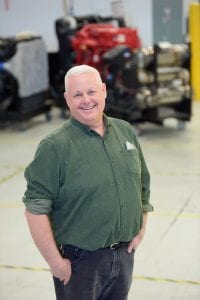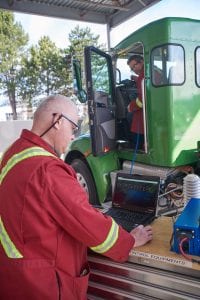
Nestled along the south arm of the Fraser River on the Annacis Island campus, BCIT’s Emission Reduction and Research Test Hub (ERRTH) is making waves around North America.
As an applied research facility, and one of only a few of its kind, ERRTH provides critical data needed to develop new technologies that reduce engine emissions from vehicles of all kinds. And demand is growing for their services.
“We have the only Portable Emissions Measurement System on the West Coast, and word is spreading,” says Bruce Thompson, the Lead Researcher and Heavy Mechanical Trades Instructor who was instrumental in establishing the facility.
Accelerating innovation
“There are so many researchers now looking for ways to reduce emissions,” explains Thompson. With the data that his team provides, researchers can now track how their innovations perform, and therefore, how to improve them. ERRTH’s testing includes all forms of transportation, from cars and trucks to boats and trains.
In the age of electrification

With more and more municipalities looking to electrify transportation systems to meet their greenhouse gas targets, the demand for people who are trained in the latest technologies is growing. Thompson is happy to be part of the wave. “Most people in the general public think [electrification] is far away but it’s right here,” he says.
“Most machines are electronically controlled now,” he says, “the first thing [mechanics] do isn’t taking out their toolbox anymore—most people take out a laptop or cell phone.”
For Thompson, learning the new technologies and teaching students is the most exciting part. His latest project is building an electric model truck: “No more dirty diesel, it’s very exciting.”
According to Thompson, the move away from gas- and diesel-powered engines has multiple benefits. It doesn’t just improve air quality and reduce climate altering greenhouse gases, it also cuts down on noise pollution, which can impact wildlife.
Training a new generation of mechanics

The diversity of programs offered at the Annacis Island Campus often surprises people. “We say we’re [BCIT’s] best kept secret,” adds Thompson. He and his colleagues teach heavy duty mechanics with applications in commercial transport, industrial railways and marine environments.
A 500-metre long stretch of tracks with locomotives, rail cars and other equipment immerse students in hands-on learning. “I have engines that you could put on your desk, and one from a ship that takes up an entire room,” says Thompson.
With ERRTH entering its third year, Thompson is motivated to grow their training capacity and engage students in the research. “Not only is it challenging, it’s also exciting,” says Thompson, “We’re trying to do our part to clean our environment.”
Meet Bruce, and take a virtual tour of the ERRTH lab.
This story is part of the monthly Countdown to Ecocity 2019 series, which highlights BCIT’s leadership in the face of today’s complex environment challenges. This initiative supports the Ecocity Standard for Clean Air, which examines air quality from within buildings to the atmosphere around us.
Learn more about BCIT’s role as host of the Ecocity World Summit in 2019.
